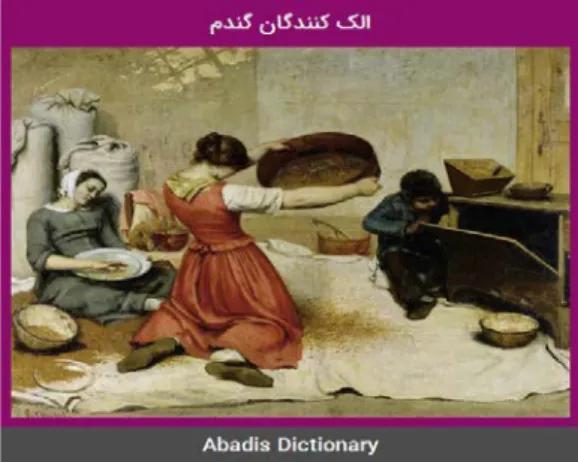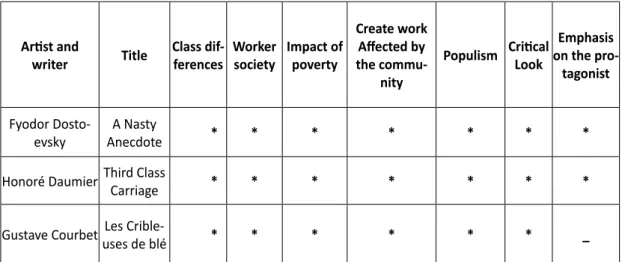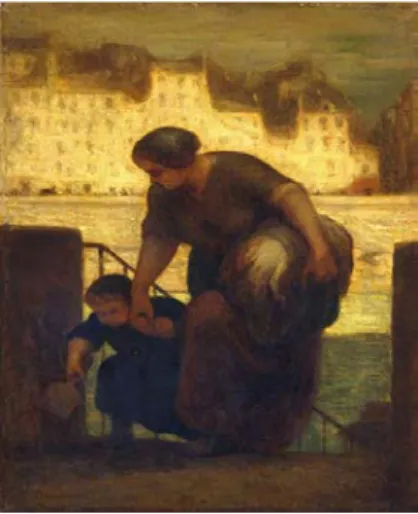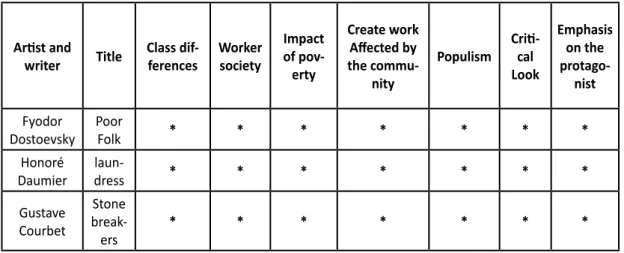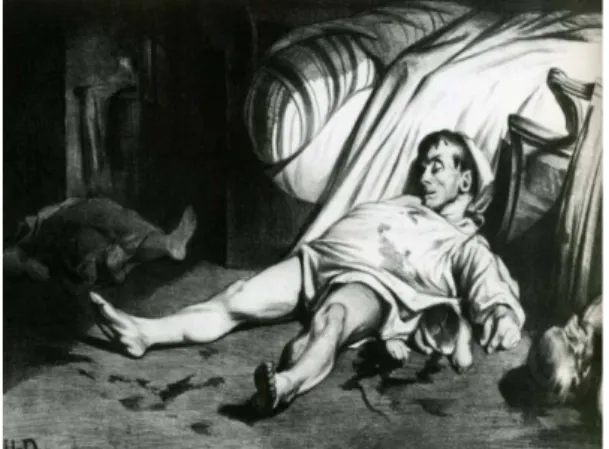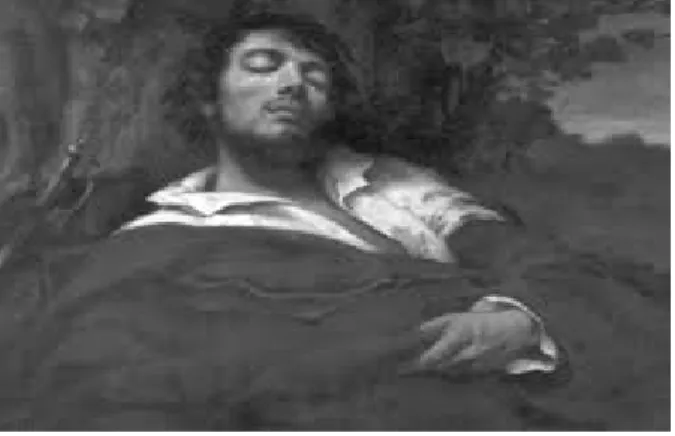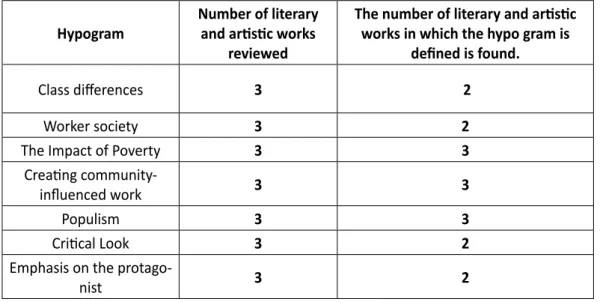Courbet, and in the literature of Fyodor Dostoevsky who has created works on the themes of social realism. The purpose of this investigation, is investigate the principle that How and to what extent Dostoevsky’s writing and literature in the works of Daumier and Courbet based on the theory of intertextuality retained their original identity and to what extent the feedback of Dostoevsky’s ideas based on critical realism in Russian literature on these paintings is evident. Next, the representation of 3 Dostoevsky’s literary works in the three works by Daumier and Courbet for intertextuality is evaluated using descriptive-analytic Riffaterre theories. At the end of the research, it is concluded that Dostoevsky’s thinking based on Riffaterre’s theory of intertextuality has influenced the works of Daumier and Courbet. However, according to Riffaterre’s intertextual approach, this influence is most evident in the works of Honoré Daumier.
Keywords: Gustave Courbet. Dostoevsky. Honoré
Daumier. Intertextuality. Riffaterre.
Resumo: Filosofia, arte e literatura interagiram entre si
em vários períodos para tentar criar temas, incluindo o movimento de realismo do século XIX. Entre seus líderes estão Pintura, Honoré Daumier e Gustave Courbet, e na literatura de Fyodor Dostoevsky, que criou obras sobre os temas do realismo social. O objetivo desta investigação é investigar o princípio de que Como e até que ponto os escritos e a literatura de Dostoiévski nos trabalhos de Daumier e Courbet, baseados na teoria da intertextualidade, mantiveram sua identidade original e em que medida o feedback das idéias de Dostoiévski baseado no realismo crítico na literatura russa sobre essas pinturas é evidente. Em seguida, a representação das obras literárias de 3 Dostoiévski nas três obras de Daumier e Courbet para intertextualidade é avaliada usando as teorias descritivas-analíticas de Riffaterre. Ao final da pesquisa, conclui-se que o pensamento de Dostoiévski, baseado na teoria da intertextualidade de Riffaterre, influenciou os trabalhos de Daumier e Courbet. No entanto, de acordo com a abordagem intertextual de Riffaterre, essa influência é mais evidente nas obras de Honoré Daumier.
Palavras-chave: Gustave Courbet. Dostoiévski. Honoré
Daumier. Intertextualidade. Riffaterre.
MA. Student of Art Research, North Tehran Branch, Islamic Azad University, Tehran Iran. E-mail: momenipoursamira@gmail.com
Assistant Professor, Department of Art, North Tehran Branch, Islamic Azad University, Tehran Iran. E-mail: elhamkashani27@yahoo.com
Assistant Professor, Department of Philosophy, North Tehran Branch, Islamic Azad University, Tehran Iran.
E-mail: amenehgharavi13@gmail.com
Samira Momenipour Elham Asar Kashani Amemeh Gharavi
UM ESTUDO DA REPRESENTAÇÃO
DOS PENSAMENTOS DE DOSTOIÉVSKI
NAS OBRAS DE HONORÉ DAUMIER
E GUSTAVE COURBET, COM BASE NA
TEORIA DA INTERTEXTUALIDADE
THE WORKS OF HONORÉ DAUMIER
AND GUSTAVE COURBET
BASED ON
THE THEORY OF INTERTEXTUALITY
1
2
3
1
2
3
Introduction
Since every work of art or literature is shaped by the transformations of society and the context in which the age is created. Meanwhile, the nineteenth century can be regarded as the golden century of Russian literature. In this century, great literary works by Russian writers emerged on the field. Dostoevsky is one of the writers who emerged in this field and had a significant impact on this boom. Among the influential factors at that time were the ba-ckground to the formation of Russian art and literature and it was often impossible to create artistic and literary work in Russia without those elements, somehow it comes back to the pro-blems of society; Therefore, the literature and artwork created during this period reflects the issues of society in its time. The impact of events in society is evident in both art and literary work. In addition to Dostoevsky, who is one of the pioneers of Russian writing in Russia; two painters named Honoré Daumier and Gustave Courbet can also be mentioned: They created the work based on the social problems of the society that led to problems such as poverty, ca-pitalist system and industrial economy. From the intertextuality perspective there are several questions and hypotheses in the process of this research; including: According to the theory of intertextuality, how and to what extent does the representation of Dostoevsky’s ideas in Daumier’s and Courbet’s works retain their original identity? And how and to what extent is Dostoevsky’s feedback based on critical realism in Russian literature evident in the paintings of Honoré Daumier and Gustave Courbet? These questions will be answered in the light of the aforementioned perspective.
Methodology
This research is a descriptive-analytical method and it is applied in purpose. In this study, we describe and analyze the works of Daumier and Courbet’s paintings based on Dostoevsky’s theories and writings. In terms of implementation, Dostoevsky’s multi-tasking analysis and evaluation will be addressed and from the perspective of intertextuality the common features of these works are analyzed in the paintings of Honoré Daumier and Gustave Courbet.
Theory of Intertextuality
Intertextuality theory is one of the most important literary and philosophical theories of the twentieth century, which invented by Julia Kristeva, lady philosopher, psychoanalyst, and Bulgarian novelist. Since the invention of this theory, which has been around for 50 years, various fields have been analyzed and expanded. Intertextuality theory is the formation of the meaning of the text by other texts, which may include borrowing and altering another text by the author or referring the reader to another text. Intertextual means to form new text based on contemporary or previous texts; So that the new text is a compact of a number of texts whose boundary is obscured and its structure updated. The term intertextuality refers to the various relationships of texts in terms of form and meaning. Texts provide contexts that can create and interpret other texts within them. The basic premise of the theory of intertextuality is that no text is without a pre-text and that the texts are continuously constructed on the basis of past texts (Namvar Motlagh, 27: 2011).
Riffaterre Intertextuality
Michael Riffaterre is a prominent American and French scholar whose theories on se-miotics and intertextual reading are well known. In his view, intertextuality is based on the reader’s understanding of the relationships between a work and other works that have been written before or after. All of these works are intertextual. Also, “the set of texts that come to the reader’s memory by reading a piece of text means” intertextuality “(Qumimi & Keshavarz, 28: 2018). He distinguishes between meanings in the literary context; because, in his view, the hallmark of the literary work is its “inner unity”.
He knows the meaning of what the reader expects from reality; but the implication che-ck is the reading cheche-ck and his intertextual semiotics is considered the way the reader reads the text and the interpretation and understanding of the meaning of the text.
cate-gories that the reader must consider in order to understand the implications. The first groups are homologies that Riffaterre calls “unrelated” and can be examined by identifying semantic clusters in the text. In this case, the reader is confronted with items in the text that are linked through a single semantic element. Guides that do not have a logical relationship do not refer to a guide, but evoke a common meaning. The second category is homology with a “hybrid relationship” that can be identified by identifying words used in descriptive systems. The term hypo gram is one of the key concepts of Riffaterre’s theory for intertextual reading. Riffaterre speaks of the nuclear word in the text. He calls this “semantic core” a hypogram.
The hypogram is an important sign to understand the implication of the work. According to Riffaterre, the same concept is repeated in different contexts in each text and the center of the text becomes apparent in the structural system associated with this constant concept. Within a text there are some types of semantic structure that are not considered keywords and the reader receives them as varieties of a non-invariant. The nature of the hypogram varies: it can be a word, an idea, a sentence from a familiar text or a stereotype. In Riffaterre’s theory, the template structure has a similar bipartite intertextual structure whose interpersonal rela-tionship is similar to the relarela-tionship between the two texts and the reader is forced to search for it in other texts, enabling a contrasting intertextual understanding of the meaning of the text (Ibid.)
Dostoevsky (1881 AD-1821 AD)
Dostoevsky was a famous and influential Russian writer. His birthday is November 11, 1821 in Moscow, and his death date is February 9, 1881. His unique work features psychoa-nalysis, exploring the psychological angles of the characters in the story, and depicting riotous, sick, and psychotic people. Also, the Manifesto of the Surrealist Movement (ultra-realism) that emerged in twentieth-century Europe was also based on Dostoevsky’s writings (Brad, 27: 2016). His writings are profound and at the same time simple, philosophical and, of course and ridi-culously scary. (Ahmadi Maleki, 2000: 60). He is one of the important figures who have played an important role in shaping modernism in the artistic community and even outside the artistic community (Khakbaz, 3: 2005). To those of us who are literate, it is clear that Dostoevsky’s works were heavily influenced by his personal life. The ups and downs of his career and going to the point of being executed had made him a writer.
Fyodor Dostoevsky in his life, as well as in his works, exhibits signs of humiliation and premature suffering, someone who insists on equality with others is at the same time concer-ned about it. Heroes of the work are constantly humiliated and always exaggerated.
Honoré Daumier (1879-1808 AD)
A French painter, cartoonist, printmaker, sculptor, human sensibility and outspoken in drawing on social life, he is one of the most prominent realist artists of the nineteenth century. Mostly, he was known as a satirist; but in the last years of his life, his distinctive painting qualities were recognized and commended. He went to Paris as a youth; after learning the te-chnique of lithography (1830AD), he began his career as a cartoonist. He joined the staff of the journal La Caricature (1831AD). He was imprisoned (1832AD) for one of his designs depicting Louis Philippe (King of France) swallowing people’s gold bags. Later, he began work in Shari Wari Magazine (1835AD). Until the last years of artistic activity, he was drawing humorous political and social images for newspapers; sometimes he even printed his own designs. In his forties he turned to oil painting and took matters mainly from everyday life. He was the only prominent French painter in the nineteenth century whose art was completely independent of the academy and the hall (Pakbaz, 224: 2000). Daumier had a remarkable talent for expressing the general personality of individuals through the manifestation of physical anomaly. Daumier had a remarkable talent for expressing the general personality of individuals through the mani-festation of physical anomaly. In prints, his paintings and sculptures went far beyond displaying the moral and natural characteristics of individuals, embodying a clear and explicit notion of sentimentality. Concise expression is the most important design feature of the Daumier (Ibid: 225). Among his works: “transnonain Street” (1834); “Uprising” (about 16620) “Third Class
Carriage” (circa 1862); “The laundress” (Ibid: 226).
Gustave Courbet (1877 AD-1819 AD)
A French painter (1877-1819) led the French realism movement; and he was one of the most influential figures in the art world of the nineteenth century. He was born into a rural family in Ernan. Trained in Besançon and Paris; but he did not believe in art education (Pakbaz, 1999: 429). After leaving for Paris (1841), he studied at the Louvre the works of former masters, in particular,Velázquez and Rembrandt. After rejecting his work several times, he moved out of the official auditorium and set up an independent exhibition (1855). Later, the Impression-ists set this unprecedented Courbet action. In the Paris Commune he took charge of art and the management of museums (1871) and ordered the overthrow of the column (a symbol of the glory of Napoleon’s empire). After the defeat of the Commune, He paid a heavy price for his activities and was jailed. Eventually, he was exiled to Switzerland and passed away there
Courbet rejected the ideals of neoclassicism and romanticism and put forward the idea of realism. He believed that the artist should open only tangible and visible things; and accord-ingly, he sought to be an interpreter of his time’s habits, ideas, and landscape. By choosing subjects such as poor life and work, he paved the way for other painters who even had dif-ferent perspectives. As an artist, as well as a popular human being, Courbet had a bold and militant personality. The independence of his behavior and his opposition to traditionalism and academic education had a profound effect on French artists. Before achieving his realistic style, Courbet had a period of swing between 16th and 19th century painting.
Novel “A Nasty Anecdote” (Dostoevsky)
The story of the novel “ A Nasty Anecdote “ about a proprietor attending a wedding at one of his subordinates So that everyone can understand how humble he is and the slogans he utters about humanity are not empty. The book” A Nasty Anecdote “ was written in 1862 in the form of social realism.
The book “ A Nasty Anecdote “ “ begins with a party and serious accident. The three bureaucrats congregate in a room and, through the social class of which they are members, their conversations are about better governance of society, as well as new changes taking place in the way the country is developing. Here are two personalities known to represent conserva-tism and preserve ancient traditions. There is another character who advocates reform. Keep-ing the bourgeois and bureaucratic personality with a simple shift reduces the imagination to the real. The new changes aimed at the peasantry have brought in a lot of power and do not have enough power to penetrate the emerging class of the industrial bourgeoisie; therefore, in his imagination he seeks abstract notions of power. The assembly of the mass wedding of the lower classes of society, as well as the evolving pseudo-intellectual community that con-servative thinking is better kept at a distance. The wedding party is not only a revolutionary character, but also a group of people who are accustomed to their humble status. Here are two characters in the story who are subordinates who are aware of two things, both their own situ-ation and their ability to get out of it, which is why the author likens one of them to an ant who constantly builds and does not get frustrated. In “ A Nasty Anecdote “ book, everything goes on a symbolic level to point to the declining bureaucratic anomic status and disintegrating classes.
“Third Class Carriage” (Honoré Daumier)
One of Honoré Daumier’s best paintings is the Metropolitan Museum’s “Third Class Car-riage" that illustrates various aspects of a subject. The work dates back to 1863. Here the models are shown in the normal way they are looking for work. Third Class Carriage is a work of study of the different natures of tired travelers sitting on wooden benches, behind their comrades, and facing the viewer.
This form of work consists of solid lines that are easily seen with a pen drawn to charac-terize the bony and facial expression of the old woman’s face and rounded cheeks and breasts. Then the painter started drawing thin layers of paint on these lines in the way of sculptors and the brownish cape has distinguished the central figure from the pink girl’s shirt and for the rest
of the season, it uses spicy blue and it’s highlighted the role of humans against the coppery brown (Larkin, 2004: 164). In the first plan, there are three chairs in one room and two women sitting on the chair. One is breastfeeding a baby, the other is an old woman with a baby boy lying next to her and in the background are rows of passengers, some in full face, some in pro-file and some in back (Spender, 1972: 60).
Picture 1: Third class wagon, 64.3*87.7 oil and paint on the canvas, the Metropolitan
Museum of Art, New York, (Gardner, 2016: 756).
The representation of literary work “” A Nasty Anecdote “ In the painting “Third Class Carriage “
The class differences and references to the themes of the bourgeoisie are abundant in these two texts. In A Nasty Anecdote, the story is centered on the protagonist and the events ahead. In essence, the story is centered on a bourgeois character. Also in this story is the author’s reference to concepts such as humanity that have a special place in Dostoevsky’s wri-tings; because man from Dostoevsky’s perspective, because man from Dostoevsky’s perspecti-ve, there are examples of different and contradictory human states that show, It is a continuous endeavor, whether effective or otherwise, to attain their lost status that is not unrelated to the social and political conditions of society. In this literary work, there is a reference to human beings, which in principle are not humiliated by their personality; but because their situation is good for the subordinates of society, scorn is formed in them and accustomed to their situ-ation. As in the wake of the wreckage of the Tertiary, there is a profound understanding of the concepts of class antagonism and the emphasis on the bourgeoisie and the concerns arising from the industrialization of cities, brought the frightening glances of train travelers; thus, the-se two effects can be matched and contrasted through intertextual layers. Thethe-se two works have similarities in terms of their semantic roots; these similarities are used in Dostoevsky’s literary work underline the existence of bourgeois and working-class personalities and the exis-tence of class differences. The same is true of the “ Third Class Carriage “ in the form of painful people with helpless faces sitting on hard benches and the heightened anxiety about the in-dustrialization of cities and their lost wealth in their cold, sad faces; But the contrast between the two texts is slightly different is being strong at the same of weakness that in (Third Class Carriage) This authority and firmness are evident in the organs.
Dostoevsky’s “ A Nasty Anecdote “ designed the subordinate characters to fit the con-cept of inferiority; the nature of the hypogram of these two texts varies, this can be seen as the idea of a bourgeois system of class and class divisions.
«Les Cribleuses de blé )»Gustave Courbet(
In Ernan during the winter of 1853-1854, Courbet depicted a scene of peasant life that was immortalized. He also selected the members of the scene from among his family mem-bers. In the middle of the scene, his sister, Zoe, sifts wheat using a large sieve; Behind him, Juliet, the painter’s second sister, hand-cuts the seeds from the thorns and shavings. Lastly, on the right, a young boy, known as his real son, examines the mechanism of the wheat mill sifted
by a ventilator. On the surface of this painting canvas, shades of soil color reduce the warm natural color of scattered wheat on the ground. The only colors of the Juliet shirt and the boy’s coat, which are inclined to the two sides of the main canvas, are cool and crisp, while chromatic intensity is predominant in red-orange- Zoe. A powerful betrayal movement that screened him increases the sensitivity of the position - she kneeled - and her body struggled steadily. Zoe fills this canvas with his almost anonymous face, while the other two characters - Juliet who is in the middle of her dream job and the baby boy who literally has reached the point of absurdity by thinking of these weeds - appear as extra pictures.
An existing table of this work, also known as Courbet’s “Criticism” or “Dobbs’ kid” Sig-nificant sustainability reflects the growth of wheat in Dobbs in the mid-19th century and the need for the farmer to use all his family members to reach comfort. At that time, the farmland in the area grew significantly. This evolution depends on expanding cereal spaces and improv-ing agricultural tools in the region.
Figure 2: Les Cribleuses de blé 167 *131 cm, Oil Paint, Nantes Museum of Fine Arts
The Representation of the literary work “ A Nasty Anecdote “in” Cribleuses de blé”
As is evident in the literary work of “ A Nasty Anecdote,” The main origins of this work refer to the bureaucratic strata of society and the bourgeois system of crisis-centered settle-ment and changes centered on class conflict. References to the land and agricultural spaces and livelihoods of the peasants are all meaningful ones that are somehow shared by the wheat sifter. Courbet has also preserved the daily rituals of family life through the wheat sifter. It also looks at how family members could make a living in a society that capitalizes on the capitalist system in order to make a living. The mold hypogram in these two effects has a direct emphasis on peasant life. Since Courbet himself has also been given the nickname of the peasant, and in this work he has mentioned his family members as the introduction of this class; it means that it is intertwined with society and the problems that exist in society.
So, in consequence, the mold hypogram can be regarded as the existence of class anta-gonism and pressure on the working class.
Table 1: A Novel Intertextual Representation of “ A Nasty Anecdote “ in “Third Class
Carriage “ Paintings and wheat sifter
Emphasis on the pro-tagonist Critical Look Populism Create work Affected by the commu-nity Impact of poverty Worker society Class dif-ferences Title Artist and writer * * * * * * * A Nasty Anecdote Fyodor Dosto-evsky * * * * * * * Third Class Carriage Honoré Daumier _ * * * * * * Les Crible-uses de blé Gustave Courbet
“The Poor Folk” Novel (Dostoevsky)
The first Russian genius novel has a simple structure. The whole novel is the correspon-dence of two poor characters. Middle-aged man working to copy letters to an office in Saint Pe-tersburg, he writes a letter to a girl in his neighborhood that has a distant kinship with her. This is an orphaned and ill girl who lives with her servant in an apartment opposite a middle-aged man’s apartment. All that man’s concern is to meet this girl’s needs and he does everything for her. Eventually, she becomes stranded in debt and the girl seeks a way to save herself and the man from poverty. The poor Folk’s novel is a story of poverty. The novel “The Poor Folk” is a story of the lives of miserable and miserable people who are satisfied with their death.
“ The laundress “ (Honoré Daumier)
Daumier lived in Ki Do Anju on the island of San. Louis and he had many opportunities to monitor the laundry that went back to the “san”, tired of climbing stairs and bending under the weight of packages that had to be washed. However, there is a high potential for fatigue in the body of this adult woman accompanying her child and it is clear that he has no one at home to think about. Apart from any allegory, examining this little painting makes it even more quality. The yellow color that shone on the buildings in the background was a special emphasis on the figurines (George, 1986, 14). In the first plan, a poor woman, with a heavy load on her armpit, climbs hard on the stairs leading from the river to the platform (Ibid: 19).
The figure of Laundry has strong muscles in this work and his body is large and the joints of the hands and joints of the foot are perfectly cross-sectioned; Like her broad and heavy shoulders as well as his muscular arms, whose assertiveness and breadth of work provide the totality of the desired features (Ibid: 14). In this work, emphasis is placed on the fabric, the folds of the human body. In this work, emphasis is placed on the fabric, the folds of the human body. As a result of the “laundress”, the wind chases the poor little girl on the beach. The “laun-dress” is a dramatic account of the suffering of the poor. In his work, Daumier, like many others, emphasizes the tragedy of everyday life.
Figure 3: Laundry, 48.9*33 Painting on wood, Metropolitan Museum of Art.
The Representation of the “poor Folk” literary work in “The Laundress” painting
As mentioned above, the narrative of poverty in both works is clearly stated and can be analyzed; therefore, the semantic nucleus or the Riffaterre hypogram can be termed poverty. However, this poverty is a product of the economic and social pressures exerted by the bour-geoisie. Class differences are also defined as the hypogram of these two effects.
Here too, these signifiers and explanations can be explained from Riffaterre’s point of view; but as we did, the two works are in line with this and that is how poverty works in these two works. With the “third class Carriage" we got this feedback; although the characters of Dostoevsky’s works are as free-spirited as those of Daumier’s but in Dostoevsky’s works the poverty and depravity in these characters convinces them to die. Although the Russian people were living in conditions that seemed to be nothing more than eating and sleeping and dying, but in Daumier’s work, this sense of helplessness and isolation is met with some resistance and stasis.
It seems as though the poor in Daumier, though capable of struggling with adversity like the laundress, engage in the suffering of urban life and industrialization. The main hypogram is the narrative of poverty, which is essentially the result of class differences.
«The Stone Breakers» )Gustave Courbet(
The work was drawn between 1849 and 50 by the French painter Gustave Courbet. The technique is oil paint on canvas and created in the form of “social realism” (Pinto, 962:1984). The subject of the work revolves around two workers, one old and one young in the hot sun, cutting and removing stones for road construction.
What with bulldozers, it’s more like a kind of punishment. The clothes are torn to pieces, and the faces of both are not clear. Also their identity does not matter. They are just workers.
In terms of composition, the board is divided into two symmetrical halves, which halves the two characters mentioned in the tableau. The rough texture of the rocks creates a visu-al rhythm and movement and visu-also creates a heavy weight at the bottom of the panel. This apparent violence is perfectly coordinated with the violence involved in the crushing of these people.
This is one of the earliest works depicting Courbet’s advocacy of everyday life as the only authentic subject for the artist of the modern age, in which this painter of realism takes a brief look at the humble and humble life of rural workers. Courbet depicts two workers - one 70 and one very young - breaking pieces of stone, traditionally a job given to members of the French lower classes. By bringing the two together, Courbet tells the viewer that humans would re-main poor for the rest of their lives if they were born in a poor environment. Courbet’s interest in poor labor as a subject for painting had a particular resonance for viewers of his work in mid-nineteenth-century France (Gardner, 2016: 753). This painting has been in the works since the publication of the Communist Party Manifesto (written by Karl Marx and Friedrich Engels) and seems to be unaffected. The village must recognize its place in a mythical plot. In this work,
the rural community is depicted; with its classes and privileges and Courbet has focused his attention on the village bourgeoisie.
Figure 4: stone breakers 157/5*195cm.Oil colored, formerly a photographer, Dresden
(Gardner, 2016: 753).
The Representation of the Literary Work of the “Poor Folk” In the “stone breakers” painting
As critiqued in the literary work of the poor Folk, one of Dostoevsky’s most famous novels, such as class differences and the mood of the poor; stone breakers can also study these common concepts as hypograms in dealing with these two effects. The stonebreakers work also describes the form and structure of the work in isolation from its content alone, which illustrates the impoverishment and pressure on the working class. One of the semantic underpinnings of the two works is the presence of an elderly person who struggles to escape the quagmire of poverty. One of the semantic underpinnings of the two works is the presence of an elderly person who struggles to escape the quagmire of poverty. The poor Folk’s literary work is described as a young girl’s rescue from the nightmare of poverty, and the outbreak of poverty and calamity on the pressure of the two-figure cortege, especially that of a rogue el-derly person. In both these texts, the struggle with life and death is evident from poverty. Thus the poverty hypogram can be described as the common hypogram of the two texts.
Table 2: An intertextual representation of the novel of the "poor Folk» in «laundress»
and «stone breakers» paintings.
Emphasis on the protago-nist Criti-cal Look Populism Create work Affected by the commu-nity Impact of pov-erty Worker society Class dif-ferences Title Artist and writer * * * * * * * Poor Folk Fyodor Dostoevsky * * * * * * * laun-dress Honoré Daumier * * * * * * * Stone break-ers Gustave Courbet
The novel “Crime and Punishment” (Dostoevsky)
The protagonist of the novel is Radion Romanovich Raskolnikov, a 23-year-old young man with an open and curious mind. A handsome young man whose poverty and inexperien-ce has crippled him and made him an outsider to the people and life around him.Raskolnikov has a troubled mind and is constantly thinking about various issues and his mental capacity is high. He always whispers or even speaks aloud when walking. Raskolnikov is suffering from this world and its injustice. Raskolnikov cannot afford to rent a small room in which he lives and
even though his sister and mother keep on helping him, he quits university because of that. At the same time, in order to silence the creditors and make a living, he has to go to the old woman’s moneylender and earn some money by mortgaging his precious objects. Raskolnikov decides to carry out his plan and assassinate the moneylender old woman. Immediately after this crime, retribution begins. A Retributivism that turns the novel into a masterpiece, the re-tribution that begins with the torment of young conscience, a rere-tribution that is not legal yet and only in the mind of the offender has begun.
In “Crime and Punishment” we see his mental struggle and the scandal he kills and so-metimes we find that mental punishment is several times more painful than legal punishment.
(Karimi Motahar, 2002: 154).
" Transnonain Street" )Honoré Daumier(
In the lithograph of “Transnonain Street “, Daumier depicts an atrocity that, from an influential perspective, Nothing less than the “The Third of May 1808 “Goya. The title refers to a street in Paris where a sniper ambushed and killed a civilian guard anonymously. In analyzing this work we see the sad scene of the crime committed by the military forces.
The dead bodies seen are the result of protests by the working class who were killed in-nocently. In the middle of the picture we see the lifeless body of his son’s body crushed under him, showing the depth of the disaster. To the right is a corpse, with only the head and part of his shoulder identified, lying on the ground, which directs the eye to out of the picture The wrinkles, which are commonly seen as a prominent feature in most of Daumier’s works, also help to show the corpse on the ground. The shooter was part of a government force trying to suppress the workers’ demonstrations. As that deadly bullet was fired from the workers’ housing block, the rest of that guard immediately stormed the buildings and killed all of their occupants. (Gardner, 2016: 756).
Figure 5: Transnonain Street 43/7*30 cm, Lithograph, Philadelphia Museum of Art
(Gardner, 755: 2016)
The Representation of the literary work “Crime and Punishment” in the painting “Transnonain Street”
Both of these works share a common meaning and, according to Riffaterre’s theory, are two sets of texts that come to mind when reading and affect how they are implicit. In the context of both the effects of murder and crime; Of course, the crime is the result of the po-verty created by Russian social conditions. Again, in this work, the themes of the bourgeoisie emerge, and again poverty can be introduced as the second hypogram in the work; because in both the root and the source of crime, there is poverty in society. The crime committed in both works is committed by the poor and the working class.
In the literary work “Crime and Punishment” the meaning, though the concept of pu-nishment, is formed when it is primarily due to the conscience that has been caused by the murder and murder of the moneylender old woman.
pu-nishment is several times more painful than legal and physical pupu-nishment. However, the emphasis on the rationalist realist in the literary work of crime and retribution is the result of atrocities in psychotic and exceptional human beings that include the heroic characters of the work. It has been summarized - that the perpetrators of the crime have also been committed by these men themselves.
The hypograms in these two texts are at the first step of crime and in the next steps of poverty. In most of Dostoevsky’s work there is a crime factor and it is caused by many factors. In crime and retribution, the theme is the impact of murder on the killer which Dostoevsky addresses the question of the relationship between self and the world around us, the indivi-dual and society and he considers the murder of the old usury woman as a kind of service to society in order to remove this class of people from society. Once again the title of a compa-nion in dealing with community issues is a common element in the works of Courbet, Daumier and Dostoevsky.
“The Wounded Man” (Gustave Courbet)
Portraits that Gustave Courbet has left are among his early works. The wounded man, suffering as a hero, depicts the romantic theme of this artist. While in prison, Courbet painted a portrait of himself and, since he had no model, spent time drawing on inanimate objects or objects of conservation. One of his most important paintings in prison is his own picture. The panel has a half-open window and intense air and light from the courtyard. Traditional small trees are planted in rectangular and small gardens in the courtyard that are lost in the light and show themselves only in the black background of rectangular cells. Like the black dog or the leather belt or pip or stripe collar, the window features a private Courbet on the panel. The design of this painting has a rough and crude quality that makes this work a tragic documen-tary. After Courbet’s release from prison, he sent works to the 1872 Hall that was rejected for political reasons. The grief that had plagued him during these years (in 1870 and 1875 he lost his mother, son, and sister) bowed to him and threw him into alcohol (Pinto, 1984: 33).
Gustave Courbet writes in his notes: “Throughout my life, with every change in my
mental state, I have drawn many faces; I wrote in one word of my life.”
Figure 6: Wounded Man, 81/5*97.5 cm, Oil Color, Louvre Museum, Paris (Pinto, 1984:
37).
The Representation of “Crime and Punishment” in the painting of “The Wounded Man”
However, in the literary work “Crime and Punishment” Raskolnikov committed a crime and in the end, the punishment for that crime was somehow included and though he praised his work because he had rid society of a usurper, but in the end, his suffering was caused by the doom of conscience. In the image of the “wounded man” this pain is also the result of his thoughts. However, concepts such as crime by Dostoevsky’s literary work and suffering in both paintings also represent events that have taken place in society and certain unrest in Russia has fueled poverty.
Table 3: An Intertextual Representation of the Crime and Punishment Novel in the
Pain-tings of Transnonain Street and wounded Man
Emphasis on the protago-nist Critical Look Populism Create work Affected by the commu-nity Impact of poverty Worker society Class dif-ferences Title Artist and writer * * * * * * * Crime and Punish-ment Fyodor Dosto-evsky * * * * * * * Trans-nonain Street Honoré Daumier * * * * * * * wounded Man Gustave Courbet
Conclusion
By examining the hypograms in the works, it is concluded that although the hypograms are evident in the works of Daumier and Courbet in both Dostoevsky’s literary works, but the multiplicity of hypograms in Daumier’s works has a greater representation of Dostoevsky’s work. Because the structural and content themes directly refer to some form of violence, cri-me, and exploration of the psychological angles of the characters in the story. Thus, the sharp realistic view and reference to the concepts of Dostoevsky’s mold in his works, including Crime in particular, “Crime and Punishment” and “ Transnonain Street”, include the closest hypo-grams. Although Courbet is a pop artist, but the content of his work largely illustrates the overwhelming conditions of peasant society and feudalism, which comprises only part of the representation of Dostoevsky’s works. So in answer to the first question we can say: Due to the common hypograms and the interpersonal character of the text, the texts retain their original identity. In answer to the second research question, it can be stated that: Given the pervasive-ness of the role of critical realism and social realism in Russia, the characteristic of influencers is highlighted by the ideas and ideas of prominent authors such as Dostoevsky in the field of painting.
Table 4: Examination of Mold Hypo grams in Gustave Courbet’s Paintings
The number of literary and artistic works in which the hypo gram is
defined is found. Number of literary
and artistic works reviewed Hypogram 2 3 Class differences 2 3 Worker society 3 3
The Impact of Poverty
3 3 Creating community-influenced work 3 3 Populism 2 3 Critical Look 2 3
Emphasis on the protago-nist
References
Brad, R. (2015). Fyodor Dostoevsky (A Look at Life and Works), translated by Mehran Safavi, Tehran, Ghoghnoos Publishing.
Gardner, E. (2015). the Transient Time, Translator Mohammad Taghi Faramarzi, Tehran, Kavosh Pardaz Publishing.
George P. Mandel. (1985). Introduction to the Works of Honoré Daumier, Translated by Mahin Mirabi, Tehran, Bahar Publishing.
Ghavimi Keshavarz, M, S. (2018). The Application of Michael Riffaterre’s Theory in Intertextual Reading “Draw All Than Salim to the Object and Logic of Attar”, Tarbiat Modares University Press, p. 28.
Karimi Motahar, J. (2002). A Study in the Characterization of the Method and Type of Descri-bing Subjects in Russian Literature, Journal of Contemporary World Literature Research, No. 12, p. 154.
Khakbaz, M. (2005). How to Say More Importantly (Report on the Kinetic Roundtable of Mo-dern Art at the Museum of Contemporary Art), Statue of Art and Architecture, No. 60, p. 3. Larkin, A. (2004). Honoré Daumier of the Man of His Age, Translated by Mina Sarabi, Tehran, New World Publishing.
Namvar Maltagh, B. (2011). an Introduction to the Intertextuality of Theories and Applica-tions, Tehran, Speech Publishing, p. 27.
Pakbaz, R. (1999). Encyclopedia of Art, Tehran, Contemporary Culture Publication.
Pinto, SA. (1984). Introduction to the Works of Gustave Courbet (A Study and Analysis of the Life and Works of One of the Founders of Nineteenth-Century Realism, Arabic translation by Sherwah.
Spender, A. (1972), The Painting of Fishermen and Laundry Workers and Poor Mothers, Negin Magazine, No. 78, p. 60.
Figure resources
Picture 1: The third class wagon, the source: (Gardner, 2015: 756) Picture 2: Wheat Sifter, Source Wikipedia
Picture 3: Laundry, Source :( https://www.histoire-image.org/fr/etudes/cribleuses-ble ) Picture 4: Stone breakers, Source: (Gardner, 2015: 753)
Picture 5: Transnonain Street Source: (Gardner, 2015: 755) Picture 6: The Wounded Man (Pinto, 1984: 37)
Recebido em 21 de janeiro de 2020. Aceito em 20 de fevereiro de 2020.
